
Paul Samuel 'Pops' Whiteman(March 28, 1890 – December 29, 1967) was an American bandleader, composer, orchestral director, and violist.

James Francis Dorsey, professionally known as Jimmy Dorsey, was an American jazz clarinetist, saxophonist, composer and big band leader. He recorded and composed the jazz and pop standards "I'm Glad There Is You " and "It's The Dreamer In Me". His other major recordings were "Tailspin", "John Silver", "So Many Times", "Amapola", "Brazil ", "Pennies from Heaven" with Bing Crosby, Louis Armstrong, and Frances Langford, "Grand Central Getaway", and "So Rare". He played clarinet on the seminal jazz standards "Singin' the Blues" in 1927 and the original 1930 recording of "Georgia on My Mind", which were inducted into the Grammy Hall of Fame.

Mildred Bailey was a Native American jazz singer during the 1930s, known as "The Queen of Swing", "The Rockin' Chair Lady" and "Mrs. Swing". Some of her best-known hits are "For Sentimental Reasons", "It's So Peaceful in the Country", "Doin' The Uptown Lowdown", "Trust in Me", "Where Are You?", "I Let a Song Go Out of My Heart", "Small Fry", "Please Be Kind", "Darn That Dream", "Rockin' Chair", "Blame It on My Last Affair", and "Says My Heart". She had three singles that made number one on the popular charts.
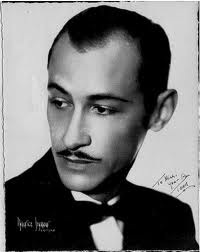
Orie Frank Trumbauer was one of the leading jazz saxophonists of the 1920s and 1930s. His main instrument was the C-melody saxophone, a now-uncommon instrument between an alto and tenor saxophone in size and pitch. He also played alto saxophone, bassoon, clarinet and several other instruments.
"What Is This Thing Called Love?" is a 1929 popular song written by Cole Porter, for the musical Wake Up and Dream. It was first performed by Elsie Carlisle in March 1929. The song has become a popular jazz standard and one of Porter's most often played compositions.
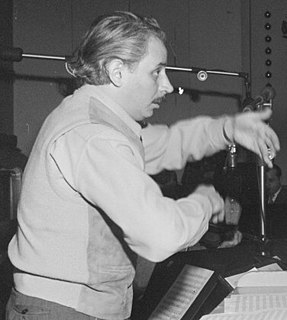
Leonard George Hayton was an American musician, composer, conductor and arranger. Hayton's trademark was a captain's hat, which he always wore at a rakish angle.
"I Want to Be Happy" is a song with music by Vincent Youmans and lyrics by Irving Caesar written for the 1925 musical No, No, Nanette.
"Pennies from Heaven" is a 1936 American popular song with music by Arthur Johnston and lyrics by Johnny Burke. It was introduced by Bing Crosby with Georgie Stoll and his Orchestra in the 1936 film of the same name. It was recorded in the same year by Billie Holiday and afterwards performed by Doris Day, Jimmy Dorsey & his Orchestra, Arthur Tracy, Eddy Duchin, Tony Bennett, Dinah Washington, Clark Terry, Frances Langford, Big Joe Turner, Lester Young, Dean Martin, Gene Ammons, The Skyliners, Legion of Mary, Guy Mitchell, and Harry James.
"Imagination" is a popular song with music written by Jimmy Van Heusen and the lyrics by Johnny Burke. The song was first published in 1940. The two best-selling versions were recorded by the orchestras of Glenn Miller and Tommy Dorsey in 1940.
"Love Walked In" is a song composed by George Gershwin, with lyrics by Ira Gershwin. The tune was composed in 1930, but the lyric was not written until 1937, for the movie musical The Goldwyn Follies (1938), where it was sung by Kenny Baker. Hit versions include Sammy Kaye (1938), The Hilltoppers (1953), Ella Fitzgerald (1959) and Dinah Washington (1960). Artie Shaw recorded the song in the early 1940s.
"Like Someone in Love" is a popular song composed in 1944 by Jimmy Van Heusen, with lyrics by Johnny Burke. It was written for the 1944 film Belle of the Yukon, where it was sung by Dinah Shore. It was a hit for Bing Crosby in March 1945, reaching #15, and has since become a jazz standard.

"Mississippi Mud" is a 1927 song written by Harry Barris, first sung by Bing Crosby as a member of Paul Whiteman's Rhythm Boys.

"I'm Glad There Is You " is a song written by Jimmy Dorsey and Paul Madeira first published in 1941. It has become a jazz and pop standard.

Annie's Cousin Fannie, which is sometimes listed as "Annie's Cousin Fanny", is a 1934 song composed by Glenn Miller and recorded by The Dorsey Brothers Orchestra for Brunswick and Decca Records. The Dorsey Brothers released two versions of the song in 1934 and 1935.
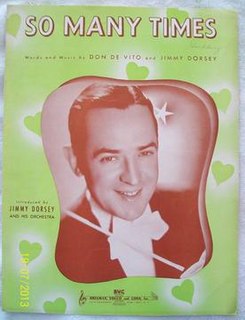
So Many Times is a 1939 song written by Jimmy Dorsey and Don De Vito. The song was released as a single in 1939 by Jimmy Dorsey and His Orchestra, becoming a Top 20 hit.
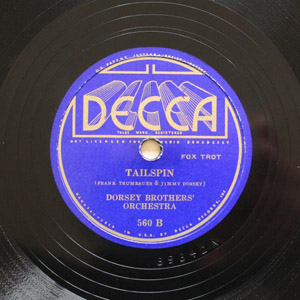
Tailspin is a 1934 song written by Jimmy Dorsey and Frankie Trumbauer. The song was released by Paul Whiteman and His Orchestra featuring Frankie Trumbauer in 1934 on Victor and by The Dorsey Brothers Orchestra in 1935 as a Decca single.
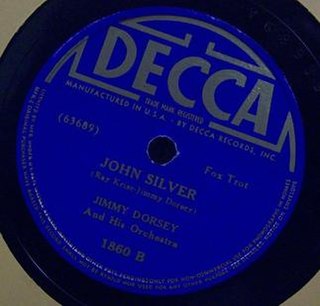
John Silver is a 1938 song written by Jimmy Dorsey with Ray Krise. Jimmy Dorsey and His Orchestra released the song as a 78 single on Decca in 1938.

"Harlem Chapel Chimes" is a 1935 jazz instrumental composed by Glenn Miller. The song was released as an A-side 78 single by the Dorsey Brothers Orchestra.
"Sweet Sue, Just You" is an American popular song of 1928, composed by Victor Young with lyrics by Will J. Harris. Popular versions in 1928 were by Earl Burtnett and by Ben Pollack.

"It Happened in Monterey" or "It Happened in Monterrey" is a 1930 song composed by Mabel Wayne, with lyrics by Billy Rose and performed by Paul Whiteman and his orchestra. It was written for the 1930 musical film, King of Jazz, and was subsequently covered several different times in short succession including by the Regent Club Orchestra, George Olsen and Ruth Etting. It fell out of popularity until Frank Sinatra re-recorded it for both his 1956 Capitol release Songs for Swingin' Lovers! and his 1957 live album Sinatra '57 in Concert.














